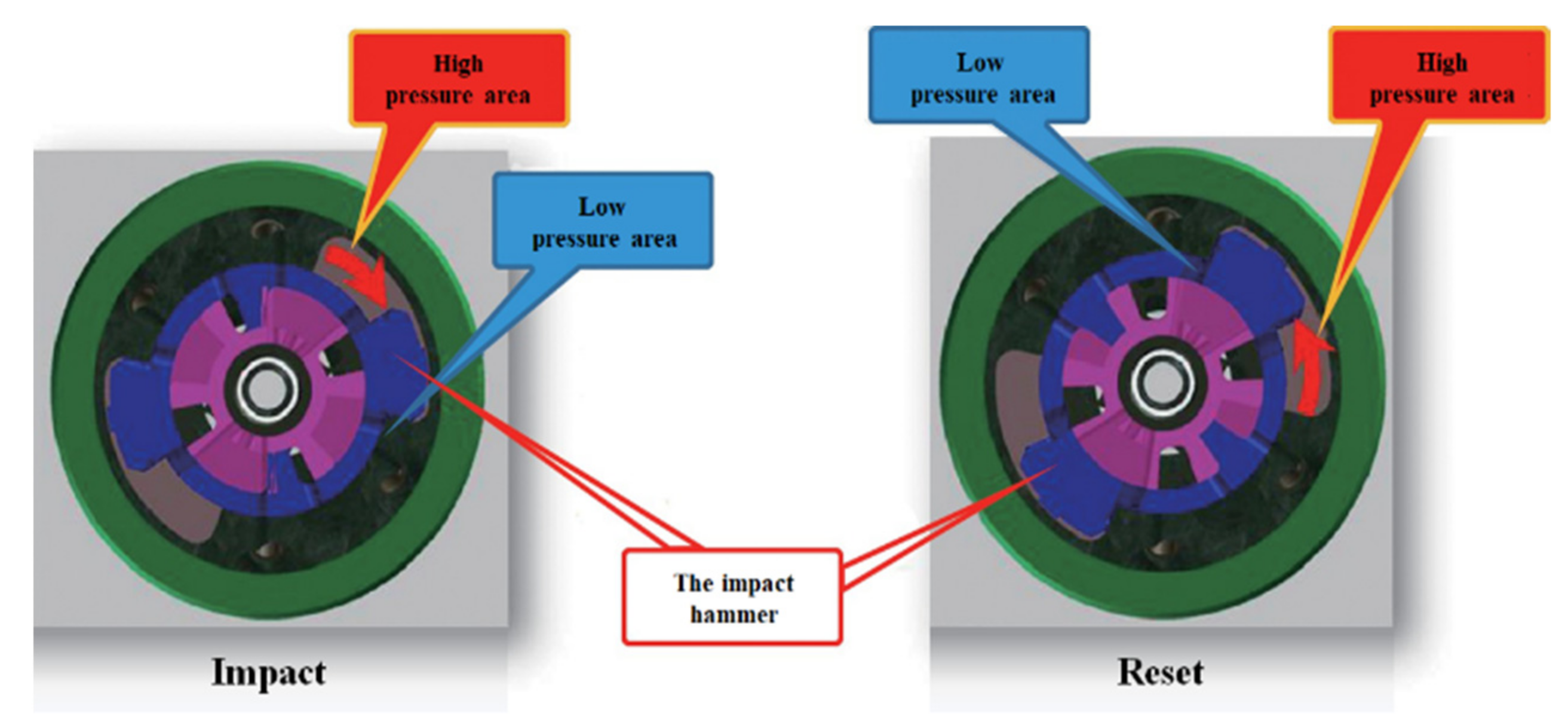A New Mechanical Specific Energy Model for Composite Impact Drilling
Abstract
:1. Introduction
2. Materials and Methods
2.1. Rock-Breaking Mechanism of Composite Impact Drilling
2.2. Mechanical Specific Energy Calculation Model of Composite Impact Drilling
3. Model Field Application Results
4. Conclusions
Author Contributions
Funding
Data Availability Statement
Conflicts of Interest
References
- Liu, G.; Li, Y.; Li, J.; Zha, C.; Zhang, T.; Huo, M. New Technology with Composite Percussion Drilling and Rock Breaking. Pet. Drill. Tech. 2016, 44, 10–15. [Google Scholar]
- Teale, R. The concept of specific energy in rock drilling. Int. J. Rock Mech. Min. Sci. 1965, 2, 57–73. [Google Scholar] [CrossRef]
- Chen, X.; Fan, H.; Guo, B.; Gao, D.; Wei, H.; Ye, Z. Real-time prediction and optimization of drilling performance Based on A New mechanical specific energy model. Arab. J. Sci. Eng. 2014, 39, 8221–8231. [Google Scholar] [CrossRef]
- Pessier, R.C.; Fear, M.J. Quantifying common drilling problems with mechanical specific energy and a bit-specific coefficient of sliding friction. In Proceedings of the SPE Annual Technical Conference and Exhibition, Washington, DC, USA, 4 October 1992. SPE24584. [Google Scholar]
- Dupriest, F.E.; Witt, J.W.; Remmert, S.M. Maximizing ROP with real time analysis of digital data and MSE. In Proceedings of the International Petroleum Technology Conference, Doha, Qatar, 21–23 November 2005. IPTC 10706. [Google Scholar]
- Duprlest, F.E.; Koederitz, W.L. Maximizing drill rates with real-time survelllance of mechanical specific energy. Presented at the SPE/IADC Drilling Conference, Amsterdam, The Netherlands, 23–25 February 2005. Paper SPE/ADC 92194. [Google Scholar]
- Hammoutene, C.; Bits, S. FEA modelled MSE/UCS values optimise PDC design for entire hole section. In Proceedings of the North Africa Technical Conference and Exhibition, Cairo, Egypt, 20–22 February 2012. SPE 149372. [Google Scholar]
- Chen, X.; Fan, H.; Gao, D.; Guo, B.; Peng, Q.; Liu, J.; Wang, E. Mechanical specific energy theory and its application in drilling engineering. Drill. Prod. Technol. 2014, 39, 8221–8231. [Google Scholar]
- Su, J.; Yuan, Z.; He, P.; Song, R. Application of HPG Composite Impactor Speed up lool in Bohai Oilfied. Ocean. Eng. Equip. Technol. 2019, 6, 457–464. [Google Scholar]
- Wang, W.; Liu, G.; Li, J.; Zha, C.; Huang, T. Structural Design and Motion Behavior Analysis of Composite Percussion Drilling Tool. China Pet. Mach. 2019, 47, 24–29. [Google Scholar]
- Chen, X.; Gao, D.; Guo, B.; Feng, Y. Real-time optimization of drilling parameters based on mechanical specific energy for rotating drilling with positive displacement motor in the hard formation. J. Nat. Gas Sci. Eng. 2016, 35, 686–694. [Google Scholar] [CrossRef]
- Li, J.; Ta, S.; Li, W.; Ya, T.; Fu, J. Research on torque and drag in extended-reach horizontal wells and its application in Chenghai-1 area. Oil Drill. Prod. Technol. 2009, 31, 21–25. [Google Scholar]





| Type | Drilling Speed up Tool |
|---|---|
| Size model | 8-1/2″186B |
| Nozzle | W20 × 1 |
| Upper connection buckle type | NC50 Box |
| Bit connection type | 4-1/2″. REG Box |
| Largest diameter | 7-5/16′ (186 mm) |
| Displacement | 25~40 LPS (400–635 GPM) |
| Pressure drop | 2.0~2.5 MPa (290-363 Psi) |
| Impact frequency | 17~23 Hz |
| Maximum operating temperature | 270 °C |
| The biggest WOB | 160 kN (35 klbs) |
| The make-up torque | 16~20 kN.m (11,792~15,000 ft-lb) |
Publisher’s Note: MDPI stays neutral with regard to jurisdictional claims in published maps and institutional affiliations. |
© 2022 by the authors. Licensee MDPI, Basel, Switzerland. This article is an open access article distributed under the terms and conditions of the Creative Commons Attribution (CC BY) license (https://creativecommons.org/licenses/by/4.0/).
Share and Cite
Qin, J.; Yin, S.; Yang, N.; Chen, X.; Tian, B.; Xue, L.; Ma, Y. A New Mechanical Specific Energy Model for Composite Impact Drilling. Appl. Sci. 2022, 12, 10356. https://doi.org/10.3390/app122010356
Qin J, Yin S, Yang N, Chen X, Tian B, Xue L, Ma Y. A New Mechanical Specific Energy Model for Composite Impact Drilling. Applied Sciences. 2022; 12(20):10356. https://doi.org/10.3390/app122010356
Chicago/Turabian StyleQin, Jianyu, Siyuan Yin, Naitong Yang, Xuyue Chen, Bo Tian, Liang Xue, and Yi Ma. 2022. "A New Mechanical Specific Energy Model for Composite Impact Drilling" Applied Sciences 12, no. 20: 10356. https://doi.org/10.3390/app122010356
APA StyleQin, J., Yin, S., Yang, N., Chen, X., Tian, B., Xue, L., & Ma, Y. (2022). A New Mechanical Specific Energy Model for Composite Impact Drilling. Applied Sciences, 12(20), 10356. https://doi.org/10.3390/app122010356





